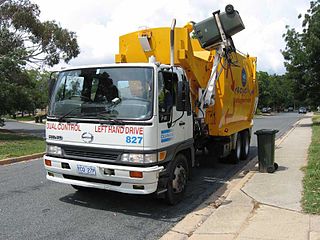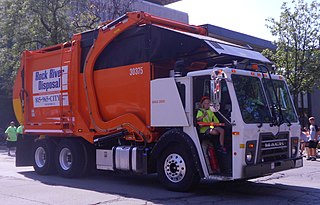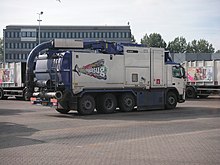
Dumpster diving is salvaging from large commercial, residential, industrial and construction containers for unused items discarded by their owners but deemed useful to the picker. It is not confined to dumpsters and skips specifically and may cover standard household waste containers, curb sides, landfills or small dumps.

A compactor is a machine or mechanism used to reduce the size of material such as waste material or bio mass through compaction. A trash compactor is often used by business and public places like hospitals to reduce the volume of trash they produce. A baler-wrapper compactor is often used for making compact and wrapped bales in order to improve logistics.

Shelvoke and Drewry was a Letchworth, Hertfordshire, manufacturer of special purpose commercial vehicles. It was best known for its innovative waste collection vehicles that were the preferred choice of municipal authorities in the UK together with their gully emptiers, cesspool cleaning vehicles and street watering and washing vehicles.

A dump truck, known also as a dumping truck, dump trailer, dumper trailer, dump lorry or dumper lorry or a dumper for short, is used for transporting materials for construction as well as coal. A typical dump truck is equipped with an open-box bed, which is hinged at the rear and equipped with hydraulic rams to lift the front, allowing the material in the bed to be deposited ("dumped") on the ground behind the truck at the site of delivery. In the UK, Australia, South Africa and India the term applies to off-road construction plants only and the road vehicle is known as a tip lorry, tipper lorry, tipper truck, tip truck, tip trailer or tipper trailer or simply a tipper.

A waste collector, also known as a garbage man, garbage collector, trashman, binman or dustman, is a person employed by a public or private enterprise to collect and dispose of municipal solid waste (refuse) and recyclables from residential, commercial, industrial or other collection sites for further processing and waste disposal. Specialised waste collection vehicles featuring an array of automated functions are often deployed to assist waste collectors in reducing collection and transport time and for protection from exposure. Waste and recycling pickup work is physically demanding and usually exposes workers to an occupational hazard.

Waste collection is a part of the process of waste management. It is the transfer of solid waste from the point of use and disposal to the point of treatment or landfill. Waste collection also includes the curbside collection of recyclable materials that technically are not waste, as part of a municipal landfill diversion program.

Mighty Machines is a Canadian educational children's television series that teaches about machines and how they work. The show premiered in 1994 airing 39 episodes over three seasons until 2008.

A waste container, also known as a dustbin, rubbish bin, trash can, and garbage can, among other names, is a type of container intended to store waste that is usually made out of metal or plastic. The words "rubbish", "basket" and "bin" are more common in British English usage; "trash" and "can" are more common in American English usage. "Garbage" may refer to food waste specifically or to municipal solid waste in general.

Kerbside collection or curbside collection is a service provided to households, typically in urban and suburban areas, of collecting and disposing of household waste and recyclables. It is usually accomplished by personnel using specially built vehicles to pick up household waste in containers that are acceptable to, or prescribed by, the municipality and are placed on the kerb.

A semi-trailer is a trailer without a front axle. The combination of a semi-trailer and a tractor truck is called a semi-trailer truck.

A dumpster is a movable waste container designed to be brought and taken away by a special collection vehicle, or to a bin that a specially designed garbage truck lifts, empties into its hopper, and lowers, on the spot. The word is a generic trademark of Dumpster, an American brand name for a specific design. Generic usage of skip, or wheelie bin may be used in other English speaking countries.
Hydraulic hooklift hoists are mounted on heavy duty trucks to enable hauliers to change out flatbeds, dumpster bodies, and similar containers. Primarily used in conjunction with tilt frame bodies and specialised roller containers, generally designed for the transportation of materials in the waste, recycling, scrap and demolition industries, as well as for disposal of construction debris.
Waste compaction is the process of compacting waste, reducing it in size. Garbage compactors and waste collection vehicles compress waste so that more of it can be stored in the same space. Waste is compacted again, more thoroughly, at the landfill to conserve valuable airspace and to extend the landfill's life span.

In North America, a roll-off is a usually open-top dumpster characterized by a rectangular footprint, utilizing wheels to facilitate rolling the dumpster in place. The container is designed to be transported by special roll-off trucks. There are two types of delivery trucks for the bins based on bin size, and they are: Hook lift bins and Roll-off bins. Roll-offs are commonly used to contain loads of construction and demolition waste or other waste types. While most roll-off containers have a swinging door on the end for easier disposal of waste, some roll-off containers are not open-top and are used with commercial or industrial trash compactors.

The Mack MC/MR series, also known as the "Cruise-Hauler", is a cabover truck first introduced in 1978. It is of a distinct "set back front axle" design, with the driver compartment mounted ahead of the front axle and with a large, flat, divided windscreen covering almost half of the truck's frontal aspect.
Ecube Labs Co., Ltd. is a manufacturer of smart and connected waste bins and solar-powered portable waste compactors, reflecting the broader, global trend of Internet of Things. Ecube Lab's garbage containers are equipped with sensors capable of monitoring their fill-level and bin status. This allows waste collectors to reduce operating costs by up to 80% through lowering collection frequency.
A bin tipper, also known as a bin-tipper, bin lifter, cart dumper or Dumpmaster, is a machine which mechanically lifts and inverts bins/carts for the purpose of emptying them. Bin tippers are a type of lifting equipment used in many industries, including waste management, food processing, chemical manufacturing and facility management.

The Mack Granite is a series of heavy duty and severe service trucks built by Mack Trucks. It has a long, low-profile hood and a high-visibility cab. Designed as straight trucks for local construction, waste removal, and other vocational jobs, it is also available as a semi-tractor. Introduced in 2001, it remains in production as of today.

The Mack TerraPro is a series of heavy duty and severe service trucks built by Mack Trucks. They are a forward control cab-over-engine type, where the driver sits in front of the axle. A flat front has two large windshields. A spotting feature is small notches in the lower inside of the windshields. It is used in refuse service and for construction concrete pumps.

The Mack LR(Low Ride) is a series of heavy-duty trucks built by Mack Trucks. They are a forward control cab-over-engine type, where the driver sits in front of the axle. A flat front has two large windshields. The cab is very low-profile and has dual driving controls with a stand-up driving position on the right side. It is used in refuse service with front, side, and rear-loading refuse compactor bodies. Introduced in 2015 it remains in production in 2020.


































